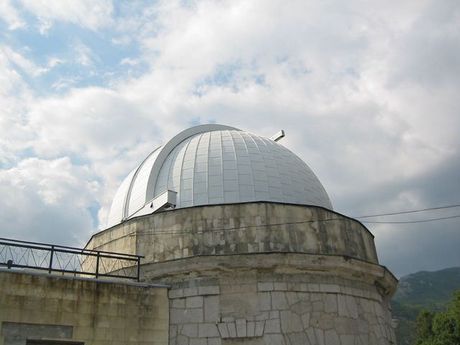Simeiz Observatory
Leading center for astrophysical research, located at Simeiz in south Crimea, between Sevastopol and Yalta, and operated by the Russian Academy of Sciences. Its principal instruments are a 2.6-meter (102-inch) optical telescope, a 22-meter (72-foot) radio telescope used for observations in the millimeter-wave region, and a solar telescope.
Fine weather conditions - cloudlessness, dryness and transparence of the air played an important role in the history of Simeiz (or Simeis). There was created an astronomic observatory. Some fundamental research, like the discovery of such a phenomenon as the star rotation by Academician G.A.Shain, the exploration of the isotopes of carbon in the stars brought to the scientists from Simeis world-wide appreciation. Great work was held to observe asteroids - small planets. Simeis scientists discovered more than a hundred of such heavenly bodies.
Part of the Crimean Astrophysical Observatory, it is currently used for laser based studies of the orbits of satellites.
Simeiz observatory organized by an amateur astronomer and later Honored member of the Academy of Science, M. Maltsov In 1900 he built a tower for refractor at his land plot near Simeiz. In 1906 - a tower with dome for Zeiss double astrograph. Both towers are preserved and being used nowadays. I11 1908, M. Maltsov handed his observatory to Pulkovo observatory as a present. In 1912, the first astrophysical department of Pulkovo observatory was officially opened at the south of Russia. Simeiz observatory is situated at the level of 360m above sea level at southern mountainside of the Crimean mountains, at Koshka mountain. A main building was restored after the Second World War on the basis of old building in modernized style with balconies decorated by columns.
Research of interstellar space and star formation zones, discovery of star rotation, creation of stellar catalogues of ray velocities, study of chemical composition of stars and the Sun brought the world publicity to Simeiz observatory. The results of research of stars and the Sun represents an independent value.
The Department provides observing facilities for astronomers of international community and for its own staff. The following projects currently run:
Two thirds of the century the astronoms were on watch on Mount Koshka. After the War when the Crimean Astrophysical Observatory in the settlement Nauchny near Bakhchisaray was founded the observatory in Simeis stopped working. Now one of the branches of the system 'Intercosmos' functions there. It's an international experimental station of lazer observations of the artificial satellites.
With the help of lazer 'shots' and using a method of location the disposition of satellites can be determined exactly.They take photoes at the same time. Beneath white domes of the lazer station a parabolic aerial can be seen, with it's help in 1959 a picture of the dark side of the Moon was obtained for the first time. It was transmitted by the automatic interplanet station 'Luna-3'. Now this aerial is raising above Simeis as a monument of one of the stages in space exploration. You can get there by direct flight to Simferopol or through Kiev or Odessa.




